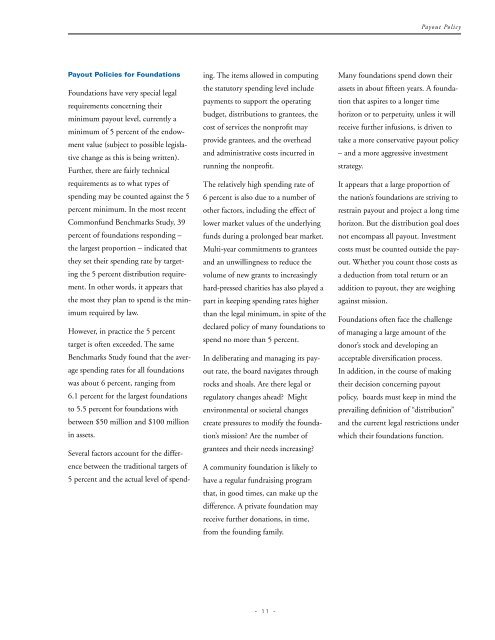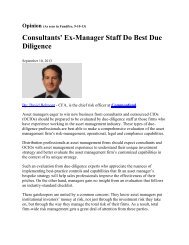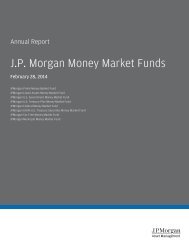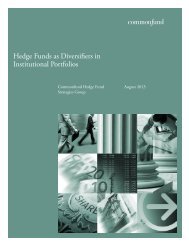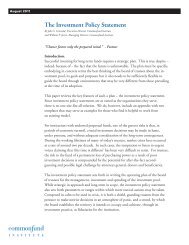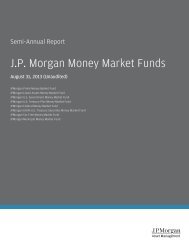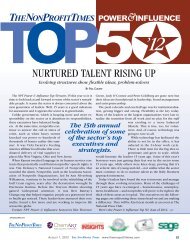Principles of Nonprofit Investment Management - Commonfund
Principles of Nonprofit Investment Management - Commonfund
Principles of Nonprofit Investment Management - Commonfund
You also want an ePaper? Increase the reach of your titles
YUMPU automatically turns print PDFs into web optimized ePapers that Google loves.
Payout PolicyPayout Policies for FoundationsFoundations have very special legalrequirements concerning theirminimum payout level, currently aminimum <strong>of</strong> 5 percent <strong>of</strong> the endowmentvalue (subject to possible legislativechange as this is being written).Further, there are fairly technicalrequirements as to what types <strong>of</strong>spending may be counted against the 5percent minimum. In the most recent<strong>Commonfund</strong> Benchmarks Study, 39percent <strong>of</strong> foundations responding –the largest proportion – indicated thatthey set their spending rate by targetingthe 5 percent distribution requirement.In other words, it appears thatthe most they plan to spend is the minimumrequired by law.However, in practice the 5 percenttarget is <strong>of</strong>ten exceeded. The sameBenchmarks Study found that the averagespending rates for all foundationswas about 6 percent, ranging from6.1 percent for the largest foundationsto 5.5 percent for foundations withbetween $50 million and $100 millionin assets.Several factors account for the differencebetween the traditional targets <strong>of</strong>5 percent and the actual level <strong>of</strong> spend-ing. The items allowed in computingthe statutory spending level includepayments to support the operatingbudget, distributions to grantees, thecost <strong>of</strong> services the nonpr<strong>of</strong>it mayprovide grantees, and the overheadand administrative costs incurred inrunning the nonpr<strong>of</strong>it.The relatively high spending rate <strong>of</strong>6 percent is also due to a number <strong>of</strong>other factors, including the effect <strong>of</strong>lower market values <strong>of</strong> the underlyingfunds during a prolonged bear market.Multi-year commitments to granteesand an unwillingness to reduce thevolume <strong>of</strong> new grants to increasinglyhard-pressed charities has also played apart in keeping spending rates higherthan the legal minimum, in spite <strong>of</strong> thedeclared policy <strong>of</strong> many foundations tospend no more than 5 percent.In deliberating and managing its payoutrate, the board navigates throughrocks and shoals. Are there legal orregulatory changes ahead? Mightenvironmental or societal changescreate pressures to modify the foundation’smission? Are the number <strong>of</strong>grantees and their needs increasing?A community foundation is likely tohave a regular fundraising programthat, in good times, can make up thedifference. A private foundation mayreceive further donations, in time,from the founding family.Many foundations spend down theirassets in about fifteen years. A foundationthat aspires to a longer timehorizon or to perpetuity, unless it willreceive further infusions, is driven totake a more conservative payout policy– and a more aggressive investmentstrategy.It appears that a large proportion <strong>of</strong>the nation’s foundations are striving torestrain payout and project a long timehorizon. But the distribution goal doesnot encompass all payout. <strong>Investment</strong>costs must be counted outside the payout.Whether you count those costs asa deduction from total return or anaddition to payout, they are weighingagainst mission.Foundations <strong>of</strong>ten face the challenge<strong>of</strong> managing a large amount <strong>of</strong> thedonor’s stock and developing anacceptable diversification process.In addition, in the course <strong>of</strong> makingtheir decision concerning payoutpolicy, boards must keep in mind theprevailing definition <strong>of</strong> “distribution”and the current legal restrictions underwhich their foundations function.- 11 -


